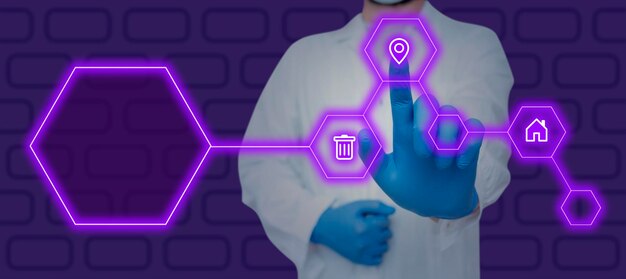McKinsey
Technology Trends Outlook 2024:
Top 5 Emerging Technologies to Watch
McKinsey & Company, a global management consulting firm, has published its annual Technology Trends report for 202The report highlights five emerging technologies that are poised to transform industries and businesses across the globe. In this article, we’ll dive deeper into these top 5 trends and discuss how they might impact your organization.
Quantum Computing: The Next Frontier in Processing Power
Quantum computing is a revolutionary technology that could solve complex problems much faster than traditional computers. With the potential to process vast amounts of data and perform advanced calculations, quantum computing could bring about breakthroughs in fields like materials science, chemistry, and logistics. Companies need to start preparing for this shift by investing in research, hiring talent, and adapting their infrastructure.
Automation Everywhere: The Future of Work
Automation, which includes robotics, artificial intelligence (ai), and machine learning, is becoming increasingly pervasive in the business world. From customer service to manufacturing, automation is changing the way work gets done. Organizations need to adapt and retrain their employees for roles that require human skills like creativity, empathy, and critical thinking.
Zero Trust Security: A New Approach to Cybersecurity
As the threat landscape continues to evolve, companies are adopting a zero-trust security model. Zero trust assumes that every user and device must be authenticated and authorized before accessing sensitive data. This approach not only strengthens security but also reduces the risk of insider threats. Companies should invest in the right tools, implement the necessary policies, and educate their employees on best practices.
Edge Computing: Bringing Processing Power Closer to the Data
Edge computing, which involves processing data closer to where it’s generated (as opposed to sending it back to a centralized data center), is becoming more important as the Internet of Things (IoT) continues to grow. Edge computing can help reduce latency, improve response times, and reduce bandwidth requirements. Organizations should consider how they can implement edge computing to optimize their operations.
5. Virtual and Mixed Reality: A New Dimension of User Experience
Virtual and mixed reality technologies are becoming increasingly sophisticated, offering new ways for users to interact with digital content. From gaming to education to manufacturing, virtual and mixed reality can provide immersive experiences that enhance productivity and engagement. Companies should consider how they can leverage these technologies to differentiate themselves from competitors and create new value for their customers.
McKinsey & Company’s Technology Trends Report: Unraveling the Significance of Emerging Technologies for Businesses
McKinsey & Company‘s annual Technology Trends Report is a highly anticipated publication that sheds light on the most emerging technologies and trends that are poised to revolutionize industries and transform business landscapes. This in-depth analysis is essential for companies and organizations looking to gain a competitive edge in today’s rapidly evolving technological landscape. By identifying these emerging technologies and staying informed about their potential impact, businesses can make strategic decisions to adapt, innovate, and thrive in the digital age.
Why Identifying Emerging Technologies Matters
In an increasingly interconnected and competitive global marketplace, staying abreast of the latest technological advancements is no longer a luxury, but a necessity. Emerging technologies have the power to disrupt industries, create new markets, and transform the way businesses operate. By recognizing these trends early and understanding their potential impact, organizations can:
Gain a Competitive Advantage
By embracing emerging technologies, businesses can gain a significant edge over their competitors and stay ahead of the curve in terms of innovation, efficiency, and customer experience.
Stay Relevant and Agile
As technologies continue to evolve at an unprecedented pace, businesses that fail to adapt risk being left behind. Identifying and investing in emerging technologies can help organizations remain relevant and agile in the face of constant change.
Enhance Operational Efficiency and Productivity
Emerging technologies can help businesses streamline their operations, automate processes, and enhance productivity, leading to cost savings, increased revenue, and improved customer service.
Examples of Emerging Technologies
Some examples of emerging technologies that are currently shaping the business landscape include: Artificial Intelligence (AI) and Machine Learning (ML), Internet of Things (IoT), Blockchain and Distributed Ledger Technology (DLT), 5G and Edge Computing, and Virtual and Augmented Reality (VR/AR).
Stay Informed and Ahead of the Curve
By staying informed about emerging technologies and understanding their potential impact on your industry, you can make strategic decisions to adapt, innovate, and thrive in the digital age. McKinsey & Company’s Technology Trends Report is an essential resource for businesses looking to stay ahead of the curve and unlock new opportunities in a rapidly evolving technological landscape.

Methodology
Description of the Research Process and Data Sources
McKinsey & Company, a leading global management consulting firm, compiled an insightful report on the top 5 emerging technologies that are expected to significantly impact businesses and industries in the next decade. The research process involved a comprehensive analysis of various dimensions, including industry trends, technological advancements, and market dynamics. The team leveraged a diverse set of data sources to gather insights. Some of these sources include:
Industry Analysis
McKinsey studied various industries to understand their current state and future trajectory, focusing on sectors with high potential for technology adoption and disruption. They analyzed industry reports, market research studies, and proprietary data to identify trends and emerging business models.
Interviews with Technology Leaders and Experts
To gain a deeper understanding of the technologies and their potential impact, McKinsey interviewed technology leaders and experts from various industries and academia. These conversations provided valuable insights into real-world applications, challenges, and opportunities associated with each technology.
Evaluation of Market Trends and Growth Potential
McKinsey assessed market trends and growth potential by analyzing historical data, forecasts, and industry projections. They considered factors such as technology adoption rates, investment trends, and regulatory environments to identify emerging technologies with significant growth potential.
Explanation of How the Top 5 Emerging Technologies were Selected
Through a rigorous analysis of various dimensions, McKinsey identified the following top 5 emerging technologies for their outlook:
Quantum Computing
Quantum computing, with its potential to solve complex problems exponentially faster than classical computers, was identified as a game-changer for industries such as finance, healthcare, and logistics.
Autonomous Vehicles
Autonomous vehicles were selected due to their potential impact on transportation, logistics, and urban planning. These vehicles could significantly reduce accidents, optimize traffic flow, and offer new business models such as ride-sharing services.
Blockchain
Blockchain technology, with its potential to create secure, transparent, and decentralized systems, was identified as a transformative force for industries such as finance, healthcare, and supply chain management.
Internet of Things (IoT)
The IoT, with its potential to connect devices and enable data collection, analysis, and automation, was identified as a key driver of innovation and growth in various industries such as manufacturing, agriculture, and healthcare.
5. 5G
5G technology was selected due to its potential to revolutionize communication and connectivity, offering significantly faster speeds, lower latency, and increased capacity. This technology could transform industries such as manufacturing, healthcare, and entertainment.

I Top Emerging Technology #1: Artificial Intelligence (AI) and Machine Learning (ML)
Artificial Intelligence (AI) and Machine Learning (ML), two of the most disruptive technologies, are revolutionizing various industries by enabling systems to learn from data, identify patterns, and make decisions with minimal human intervention.
Overview of AI and ML technologies
AI is a broad concept that refers to machines exhibiting capabilities that mimic or resemble human intelligence. ML, on the other hand, is a subset of AI that involves training algorithms to learn from and make decisions based on data. Deep learning, a popular ML technique, uses neural networks with multiple layers to model complex patterns in data.
Current state and usage of AI and ML in various industries
AI and ML are being adopted by numerous industries, including healthcare, finance, retail, manufacturing, and education. In healthcare, AI-powered systems help diagnose diseases, recommend treatments, and monitor patient health. Finance firms leverage ML algorithms for fraud detection, risk assessment, and investment recommendations. Retailers use AI-driven chatbots to provide personalized product recommendations and customer support. ML is also transforming manufacturing with predictive maintenance, quality control, and supply chain optimization.
Use cases and real-life examples demonstrating the impact and potential benefits of AI and ML
Improved customer experience: AI-powered chatbots like Apple’s Siri and Amazon’s Alexa provide personalized recommendations, answer queries, and control smart home devices. ML algorithms in email marketing platforms like Mailchimp analyze user behavior to deliver targeted campaigns.
Enhanced operational efficiency: AI in manufacturing optimizes production lines, predicts maintenance needs, and detects defects. ML in agriculture helps farmers monitor crop health and yields, reducing waste and increasing productivity.
Predictive analytics for business growth: ML-driven tools like Google Trends and Salesforce’s Einstein provide insights into consumer behavior, market trends, and sales forecasts. These predictions help businesses make informed decisions and adapt to changing market conditions.
Discussion on the ethical, regulatory, and privacy considerations surrounding AI and ML
Data security and protection: The vast amounts of data required for ML models to function necessitate robust security measures. Encryption, access controls, and secure communication protocols are essential to protect sensitive information.
Human bias and fairness in AI algorithms: There is a growing concern regarding potential human bias in AI algorithms, which can perpetuate existing social disparities. Developers must ensure their models are fair and unbiased to mitigate any negative societal impacts.
Transparency and accountability: As AI systems become more complex, it can be challenging to understand how they arrive at decisions. Ensuring transparency in the development and deployment of these technologies is crucial to build trust and maintain ethical use.
End of Content

Top Emerging Technology #2:
Quantum Computing
Definition and explanation of quantum computing technology: Quantum computing is a new era in information processing that uses the principles of quantum mechanics to perform complex calculations. Unlike classical computers that use bits (binary digits) to represent and process data, quantum computers use qubits (quantum bits), which can exist in multiple states at once. This unique property called superposition allows quantum computers to solve certain problems exponentially faster than classical computers.
Current state and progress in the development of quantum computers:
Several companies, including IBM, Google, Intel, and Microsoft, are actively investing in developing quantum computing technology. IBM has made significant strides by creating a 53-qubit processor, while Google claims to have achieved “quantum supremacy” with its 72-qubit Sycamore processor. Despite these advancements, there are still challenges in building larger, more stable qubits and error correction methods to mitigate the noise and decoherence that affects their performance.
Use cases and potential benefits of quantum computing for industries:
Optimization of complex systems:
Quantum computers can help industries solve optimization problems by calculating the best possible solution among an enormous number of possibilities in a fraction of the time. This includes route planning, scheduling, and resource allocation for logistics companies.
Rapid data analysis and processing:
Quantum computers can process and analyze large datasets much more efficiently than classical computers, providing valuable insights in fields like finance (risk assessment, portfolio optimization), healthcare (drug discovery, genetic research), and materials science.
Breaking encryption algorithms:
Quantum computers pose a significant threat to current encryption methods, such as RSA, which are based on the difficulty of factoring large numbers. This could potentially disrupt industries that rely heavily on data security, like banking and finance.
Challenges and limitations of quantum computing:
Despite its potential benefits, quantum computing faces several challenges and limitations. One major limitation is the high energy consumption required to maintain qubits in their superposition states. Additionally, the hardware requirements for building large-scale quantum computers are still a significant challenge, as they need to be operated at extremely low temperatures and shielded from external disturbances.
Top Emerging Technology #3: Blockchain and Decentralized Finance (DeFi)
Introduction to Blockchain Technology
Blockchain is a decentralized, digital ledger technology that records transactions across multiple computers. First introduced in 2008 through Satoshi Nakamoto’s bitcoin whitepaper, blockchain has since revolutionized the way we store and transfer data. Initially developed for digital currencies, blockchain now offers various applications, including supply chain management, digital identity verification, and more.
Overview of Decentralized Finance (DeFi)
Decentralized Finance (DeFi) is an umbrella term for financial services, instruments, and applications built on blockchain technology. Gaining traction since 2017, DeFi has disrupted the traditional financial services industry by providing decentralized alternatives to intermediaries like banks.
Use Cases and Advantages of Blockchain and DeFi
Advantages in Banking:
Increased Transparency and Security: Blockchain enables real-time, secure transactions while offering an immutable record of each transaction.
Reduced Intermediaries and Costs: DeFi removes the need for intermediaries, lowering costs for financial services.
Enhanced Privacy and User Control: Individuals have greater control over their data and transactions.
Advantages in Supply Chain:
Immutable and Traceable Records: Blockchain ensures transparency throughout the supply chain, from production to delivery.
Increased Efficiency: Automating processes and reducing manual work saves time and resources.
Fraud Detection: Blockchain’s immutable ledger makes it easier to identify and prevent fraudulent activities.
Advantages in Digital Identity:
Decentralized Verification: Users own and control their identity information, eliminating the need for third-party verification.
Immutable Records: Digital identities are immutable, reducing the risk of identity theft.
Privacy and Security: Blockchain ensures users’ privacy while maintaining security.
Regulatory Challenges for Blockchain and DeFi
Despite their advantages, blockchain and DeFi face regulatory challenges:
- Security: Ensuring security for user data and transactions is crucial.
- Privacy Concerns:
- Compliance with Existing Financial Regulations:
Balancing privacy with regulatory compliance is necessary.
Ensuring adherence to regulations while promoting innovation is a challenge.

VI. Top Emerging Technology #4: Edge Computing and the Internet of Things (IoT)
Definition and explanation of edge computing and IoT technologies
Edge computing refers to the practice of processing data closer to the source, rather than relying on centralized servers or cloud infrastructure. IoT (Internet of Things), on the other hand, describes a network of interconnected physical devices that can collect and exchange data over the internet. Edge computing plays a crucial role in IoT by enabling real-time analysis and processing of data generated by IoT devices.
Current state and applications of edge computing and IoT in various industries
The integration of edge computing and IoT has revolutionized various sectors. In manufacturing, these technologies enable predictive maintenance by processing data from sensors in real-time to identify potential equipment failures and schedule maintenance accordingly. In transportation, edge computing allows for real-time traffic monitoring and route optimization, while IoT sensors in vehicles enable predictive maintenance and enhance safety. In healthcare, edge computing facilitates remote patient monitoring with real-time analysis of vital signs, while IoT devices enable wearable health monitors and connected medical equipment.
Use cases highlighting the benefits of edge computing and IoT for businesses
Real-time data processing at the source:
Edge computing enables businesses to process and analyze data as it is generated, allowing for immediate responses to changing conditions. For instance, in retail, IoT sensors can track customer behavior and edge computing can analyze this data to optimize pricing, inventory management, and marketing efforts.
Enhanced automation and control:
Edge computing allows for automated responses to data generated by IoT devices, reducing the need for human intervention. In agriculture, for example, edge computing can analyze weather and soil conditions to optimize irrigation and crop management.
Improved customer experience through personalized services:
Edge computing enables businesses to deliver more personalized services by processing data in real-time and tailoring responses accordingly. For instance, in hospitality, edge computing can analyze guest behavior and preferences to optimize room temperature, entertainment options, and other services.
Challenges and limitations of edge computing and IoT
Despite their numerous benefits, edge computing and IoT face several challenges. Security concerns, such as data breaches and unauthorized access, are a major concern due to the vast amounts of sensitive information generated by these technologies. Data privacy is another challenge, as businesses must ensure that they comply with regulations regarding data collection and usage. Interoperability issues also persist, as different IoT devices and edge computing platforms may not be able to communicate effectively with one another.

V Top Emerging Technology #5: Virtual and Augmented Reality (VR/AR)
Explanation of VR and AR Technologies, Their Differences, and Applications:
Virtual Reality (VR) and Augmented Reality (AR) are two revolutionary technologies that have the power to transform various industries. While VR creates a completely artificial environment, AR superimposes digital information onto the real world. VR headsets like Oculus Rift and HTC Vive transport users to immersive 3D environments, while AR devices such as Microsoft HoloLens or Google Glass overlay digital content on the physical world. VR is commonly used in gaming, education, and training simulations, while AR finds applications in retail, manufacturing, and healthcare industries for enhanced visualization and interaction.
Current State and Adoption Rates in Various Industries:
The gaming industry has been a frontrunner in the VR revolution, with major game developers creating exclusive titles for these platforms. The educational sector is also adopting VR/AR to create immersive and interactive learning environments. In healthcare, VR/AR applications include surgical simulations, therapy sessions, and patient education. However, despite their potential benefits, VR/AR technologies still face challenges such as high costs, compatibility issues, and privacy concerns that limit their widespread adoption.
Use Cases Demonstrating the Potential Benefits of VR/AR for Businesses:
Immersive Product Demonstrations:
VR/AR allows businesses to offer customers immersive product demonstrations, enabling them to visualize and interact with products in a more engaging way. For instance, real estate companies can create virtual tours of properties for potential buyers, while automotive manufacturers can showcase their vehicles through VR experiences.
Real-time Collaboration and Communication:
VR/AR technologies enable remote teams to collaborate and communicate in real-time, breaking down geographical barriers. This is particularly valuable for companies with international branches or distributed workforces. For example, engineers can review designs together in a virtual environment and discuss improvements, and marketing teams can conduct product presentations in an immersive setting.
Enhanced User Engagement:
VR/AR technologies can significantly increase user engagement by offering personalized, interactive experiences that go beyond traditional content. Retailers, for instance, can create AR shopping experiences where customers can try on clothes virtually or preview home decor items in their own space.
Challenges and Limitations of VR/AR:
Despite their immense potential, VR/AR technologies face several challenges that hinder their widespread adoption. High costs associated with purchasing the necessary hardware and software, as well as ongoing maintenance, can be prohibitive for many businesses. Compatibility issues between different VR/AR devices and platforms further complicate matters. Privacy concerns related to data collection, storage, and sharing are also a significant barrier for individuals and organizations alike.

VI Conclusion
In this report, we’ve explored the top 5 emerging technologies that are poised to revolutionize businesses and industries across the board. These game-changers include:
Artificial Intelligence (AI)
With its ability to learn, reason, and self-correct, AI has the potential to automate repetitive tasks, improve decision making, and enhance customer experiences.
Internet of Things (IoT)
The IoT’s interconnected network of physical devices, vehicles, buildings, and other items offers endless opportunities for optimizing operations, improving efficiency, and creating new business models.
Blockchain
This decentralized digital ledger system offers security, transparency, and immutability, making it an ideal solution for industries dealing with complex transactions, such as finance and healthcare.
Augmented Reality (AR) and Virtual Reality (VR)
AR and VR technologies can create immersive experiences, train employees, enhance product design, and transform the way we interact with digital content.
5. Quantum Computing
This next-generation computing technology can process vast amounts of data at unprecedented speeds, making it invaluable for industries dealing with complex calculations and large datasets.
Recap
Recap: These five technologies represent significant advancements in their respective fields and offer immense potential for businesses and industries. By understanding these trends and their potential impact, organizations can prepare themselves for the future.
Importance
Importance: Staying informed about these trends is crucial for organizations, as they can help businesses adapt to changing market conditions and remain competitive. Failure to embrace emerging technologies might result in missed opportunities or even being left behind.
Call-to-action
Call-to-action: Explore the report in full to gain a deeper understanding of these emerging technologies, their applications, and potential implications for your organization. Don’t miss out on this valuable opportunity to stay ahead of the curve.







